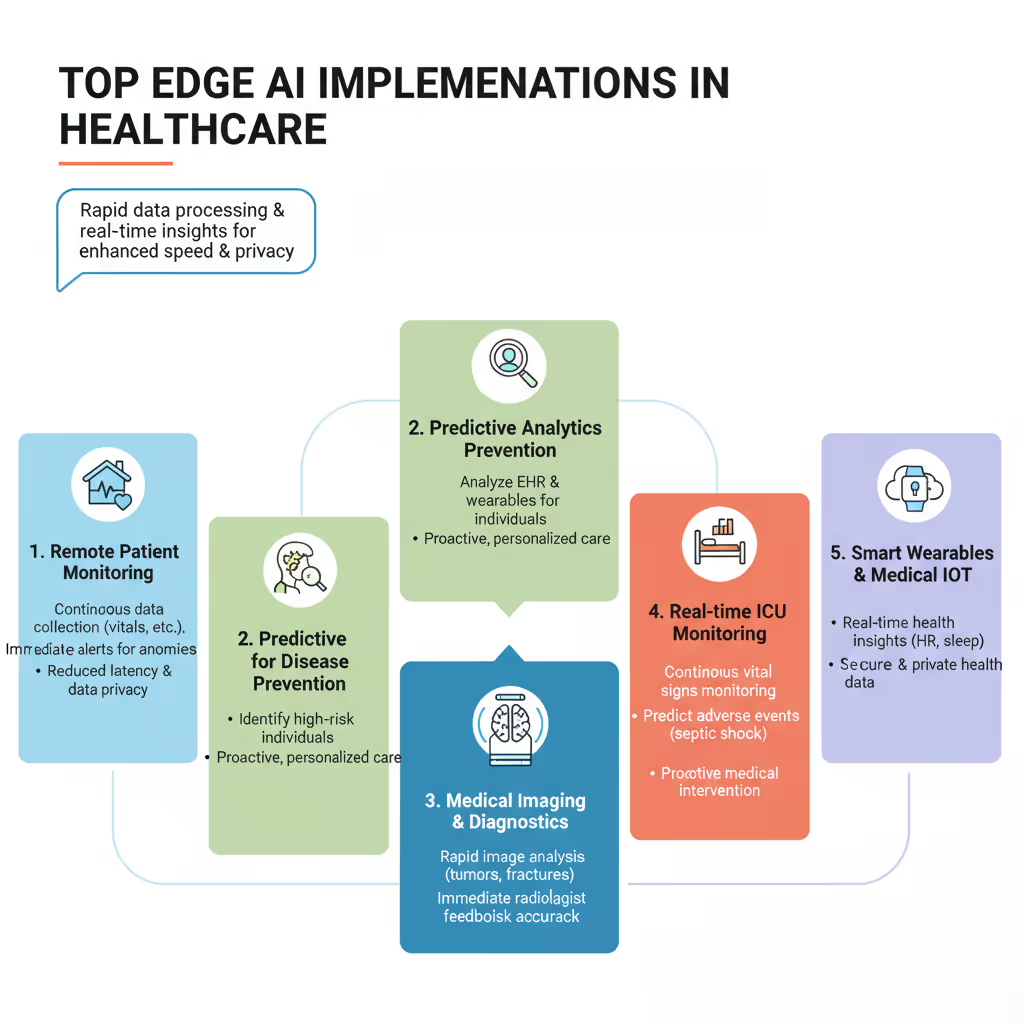Edge AI Implementations in Healthcare

Edge AI implementations in healthcare are redefining how U.S. hospitals and providers deliver care in 2025. Instead of sending sensitive patient data to distant servers, edge AI processes information directly on devices, ensuring faster insights and HIPAA-compliant security. From AI-powered imaging in radiology to real-time patient monitoring in ICUs, this shift empowers clinicians with immediate, actionable intelligence. For U.S. healthcare executives balancing innovation, cost, and compliance, Edge AI is more than a technology trend, it is the foundation of smarter, safer, and more responsive patient care.
Edge AI implementations in healthcare enable U.S. hospitals to process patient data locally on medical devices and IoT systems, reducing latency, improving diagnostics, and ensuring HIPAA-compliant privacy. Common applications include remote patient monitoring, predictive analytics, medical imaging, and real-time clinical decision support. This improves outcomes while reducing cloud dependency.
What Is Edge AI in Healthcare?
Edge AI in healthcare revolutionizes patient care by processing data directly on medical devices. This approach embeds artificial intelligence into equipment at the "edge" of the network, near the source of data collection. It enables real-time analysis and decision-making without the need to send information to a centralized cloud server.
Here are some key aspects of Edge AI in healthcare:
- Difference from Cloud AI: Edge AI differs from Cloud AI in where it processes data. Edge AI performs analysis locally on devices like smart sensors or medical instruments. In contrast, Cloud AI sends data to remote servers for processing, which can introduce delays. This local processing allows Edge AI to provide immediate insights.
- Importance of low latency: The low latency of Edge AI is crucial in healthcare for several reasons. It allows for real-time responses in critical situations, which is vital for applications like remote patient monitoring and emergency care. For example, a wearable device can instantly detect an irregular heartbeat and alert both the patient and doctor, enabling faster intervention and potentially better outcomes.
- Enhanced privacy and reliability: By processing sensitive patient data locally, Edge AI enhances privacy and security by minimizing the transfer of data over networks. This also improves reliability, as the system can continue to function even with poor or no internet connectivity, which is especially important in remote or underserved areas.
Why U.S. Healthcare Needs Edge AI
Edge AI is transforming U.S. healthcare by moving artificial intelligence from the cloud to local devices. This shift allows for data processing to happen closer to where it is collected, offering significant improvements in privacy, cost-efficiency, and speed.
- Edge AI enhances data privacy and helps organizations meet HIPAA compliance standards. It processes sensitive patient information on local devices, like hospital servers or medical instruments, instead of sending it to a remote cloud. This local processing keeps protected health information (PHI) within the healthcare facility's secure network, greatly reducing the risk of data breaches during transmission and simplifying adherence to HIPAA's strict security rules.
- This technology effectively addresses bandwidth and cost limitations that challenge many healthcare providers. Medical imaging files, such as MRIs and CT scans, are enormous and consume significant network bandwidth when uploaded to the cloud. By analyzing this data on-site, edge devices reduce network congestion and lower the high costs associated with cloud storage and data transfer services.
- Edge AI enables faster diagnosis and clinical decision-making, which directly improves patient outcomes. It eliminates the time lag required to send data to a central server and wait for a response, providing medical staff with real-time analytical insights. This immediacy empowers doctors to identify critical conditions more quickly and make swift, informed treatment decisions in time-sensitive environments like emergency rooms and intensive care units.
Top Edge AI Implementations in Healthcare
Edge AI is transforming healthcare by bringing computation and data storage closer to where data is created, rather than relying on a central server. This approach allows for rapid data processing and real-time insights without the need for a constant internet connection, enhancing the speed and privacy of medical services.
Key applications of Edge AI in the healthcare sector include:

- Remote Patient Monitoring
- Edge AI devices enable the continuous collection and analysis of patient data, such as vital signs, from the comfort of their homes.
- These systems can immediately alert healthcare providers to any anomalies, facilitating prompt medical intervention.
- By processing data locally on the device, it reduces latency and ensures patient data privacy.
- Predictive Analytics for Disease Prevention
- Edge AI algorithms analyze data from various sources, including electronic health records and wearables, to identify individuals at high risk for certain diseases.
- This allows healthcare professionals to develop proactive and personalized care plans.
- Early detection of potential health issues leads to more effective and less invasive treatments.
- Medical Imaging & Diagnostics
- In tools like MRI and CT scanners, Edge AI can quickly analyze images to detect abnormalities such as tumors or fractures.
- This capability provides immediate feedback to radiologists, speeding up the diagnostic process.
- It also improves the accuracy of diagnoses by identifying subtle patterns that may be missed by the human eye.
- Real-time ICU Monitoring
- Edge devices in Intensive Care Units (ICUs) continuously monitor patient vital signs and other critical data streams.
- The system can predict potential adverse events, such as septic shock or cardiac arrest, before they occur.
- This enables the medical team to intervene proactively, significantly improving patient outcomes in critical care settings.
- Smart Wearables & Medical IoT
- Consumer wearables and dedicated medical Internet of Things (IoT) devices use Edge AI to provide users with real-time health insights.
- These devices track metrics like heart rate, sleep patterns, and physical activity, offering personalized health recommendations.
- The on-device processing ensures that personal health data remains secure and private.
Case Studies: Edge AI in U.S. Hospitals
Leading American hospitals are adopting artificial intelligence (AI) to deliver care more efficiently and improve patient outcomes. By processing data directly at the point of care, this technology helps medical teams make faster, more informed decisions. Institutions like the Mayo Clinic, Cleveland Clinic, and Mount Sinai Health System are actively implementing AI tools to enhance safety and reduce operational delays.
Mayo Clinic
The Mayo Clinic uses AI to innovate across several medical fields, leading to more precise and faster patient care.
- Researchers developed an AI tool that more accurately and rapidly finds the source of seizures in patients who have drug-resistant epilepsy. This allows patients to get corrective surgery sooner and minimizes the risk of infection from prolonged monitoring.
- In partnership with NVIDIA, the clinic is building a digital pathology platform with the long-term goal of using edge computing. This will bring AI insights directly to the point of care, aiming to make diagnoses and treatments more personalized and accurate.
- The clinic also applies AI to detect heart disease and accelerate stroke treatment.
Cleveland Clinic
The Cleveland Clinic integrates AI to streamline complex medical and administrative processes, directly benefiting patient access to care.
- The clinic uses an AI platform to speed up the recruitment process for clinical trials. By automatically reviewing patient charts to find eligible participants, it gives more patients faster access to new and potentially life-saving treatments.
- It also deploys generative AI tools to make the medical coding process more efficient and accurate. These AI assistants can review over 100 clinical documents for a single case in about 90 seconds, a task that could take a human up to an hour.
Mount Sinai Health System
Mount Sinai employs AI-driven predictive tools to identify at-risk patients, which improves safety and ensures timely medical intervention.
- An AI model predicts which patients are at risk of falling. This solution has proven more effective than previous assessment methods and helps prevent costly injuries.
- The health system uses a predictive tool to identify patients at risk for malnutrition with over 70% accuracy. This allows dietitians to focus on patients who need help, which improves wound healing and lowers readmission rates.
- Another AI tool quadrupled the detection rate of delirium in hospitalized patients. This allows for earlier treatment and better patient outcomes.
Challenges of Edge AI in Healthcare
Edge AI brings powerful data processing directly to healthcare devices, but its widespread adoption faces several significant challenges. These obstacles range from hardware capabilities and data system compatibility to navigating the complex regulatory landscape.
Addressing these issues is essential to unlock the full potential of Edge AI in improving patient outcomes.
Hardware Limitations
- Edge devices like wearables and bedside monitors operate with limited processing power, memory, and storage compared to cloud-based systems. These constraints restrict the complexity of the AI models they can run, which can impact the accuracy of real-time health analysis.
- Most edge healthcare devices must run on batteries for extended periods. This requires developers to create highly power-efficient hardware and software that can perform demanding AI computations without quickly draining the device's energy source.
Integration with EHR Systems
- Connecting new Edge AI devices to a hospital's existing Electronic Health Record (EHR) systems is a major integration challenge. Different EHR platforms often use unique data formats and communication protocols, making seamless data exchange difficult.
- This lack of interoperability can lead to data silos, where crucial health information gathered by an edge device does not make it into the patient's central record. Without a unified view, clinicians cannot leverage the full benefits of continuous, real-time monitoring.
Regulatory Hurdles
- Edge AI devices handle sensitive patient data and must comply with strict regulations like the Health Insurance Portability and Accountability Act (HIPAA). Developers must ensure all data is securely processed and stored on the device to protect patient privacy.
- Gaining approval from regulatory bodies, such as the Food and Drug Administration (FDA), presents another significant barrier. Companies must provide extensive evidence that their AI-powered devices are safe, reliable, and effective, a process that is often long
Future of Edge AI in Healthcare
Edge AI is transforming the healthcare industry by moving computational power from the cloud to local devices near the patient. This approach enables faster data processing, strengthens patient privacy, and supports real-time medical applications directly at the point of care.
By analyzing data locally, Edge AI delivers immediate insights and facilitates quicker, more effective health interventions.
AI-Driven Personalized Medicine
- Edge AI powers personalized medicine by analyzing health data directly on a patient's device, such as a smartwatch or a remote monitor. This local processing provides immediate, actionable insights and tailored health recommendations. It allows for continuous tracking and instant alerts for conditions like abnormal heart rhythms or blood sugar spikes without cloud-related delays, enabling proactive health management.
Federated Learning for HIPAA Compliance
- Healthcare providers use a technique called federated learning to train AI models while maintaining strict HIPAA compliance. This method trains a shared AI model using data from multiple hospitals or clinics without moving sensitive patient records from their secure, original location. It enhances collaborative medical research and improves model accuracy while fundamentally protecting patient privacy.
Role of 5G and Medical IoT
- The combination of 5G technology and the Internet of Medical Things (IoMT) greatly expands Edge AI's capabilities. 5G provides the high-speed, low-latency network that IoMT devices, like smart sensors and monitors, need to transmit large volumes of data reliably. Edge AI then processes this data instantly on-site, supporting critical applications like real-time remote patient monitoring and providing data for guided robotic surgery.
Edge AI implementations in healthcare are no longer experimental, they are becoming a necessity for U.S. hospitals and providers. By enabling real-time decision-making, ensuring HIPAA-compliant data handling, and improving patient monitoring, Edge AI empowers clinicians to deliver safer, faster, and more personalized care. While challenges such as infrastructure and regulation remain, the future of healthcare in the U.S. will be increasingly defined by intelligent systems operating at the edge. For providers seeking competitive advantage, Edge AI is the bridge to smarter, patient-centered medicine.

